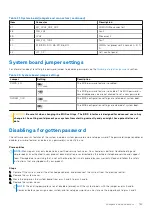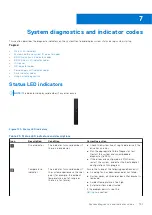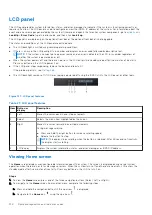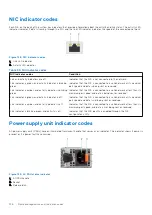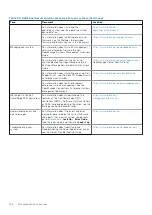
Documentation resources
This section provides information about the documentation resources for your system.
To view the document that is listed in the documentation resources table:
●
From the Dell EMC support site:
1. Click the documentation link that is provided in the Location column in the table.
2. Click the required product or product version.
NOTE:
To locate the product name and model, see the front of your system.
3. On the Product Support page, click
Manuals & documents
.
●
Using search engines:
○
Type the name and version of the document in the search box.
Table 35. Additional documentation resources for your system
Task
Document
Location
Setting up your system
For more information about installing and
securing the system into a rack, see the
Rail Installation Guide included with your rail
solution.
For information about setting up your system,
see the
Getting Started Guide
document that is shipped with your system.
https://www.dell.com/poweredgemanuals
Configuring your system
For information about the iDRAC features,
configuring and logging in to iDRAC, and
managing your system remotely, see the
Integrated Dell Remote Access Controller
User's Guide.
For information about understanding
Remote Access Controller Admin (RACADM)
subcommands and supported RACADM
interfaces, see the RACADM CLI Guide for
iDRAC.
For information about Redfish and its protocol,
supported schema, and Redfish Eventing
implemented in iDRAC, see the Redfish API
Guide.
For information about iDRAC property
database group and object descriptions, see
the Attribute Registry Guide.
For information about Intel QuickAssist
Technology, see the Integrated Dell Remote
Access Controller User's Guide.
https://www.dell.com/poweredgemanuals
For information about earlier versions of the
iDRAC documents.
To identify the version of iDRAC available on
your system, on the iDRAC web interface, click
?
>
About
.
https://www.dell.com/idracmanuals
9
Documentation resources
143

